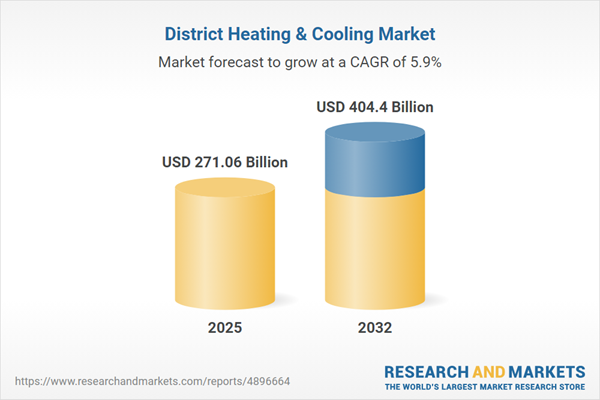Speak directly to the analyst to clarify any post sales queries you may have.
District heating and cooling solutions are transforming how urban centers worldwide approach energy efficiency, emissions management, and the resilience of critical infrastructure. As senior leaders assess strategic investments, navigating the complexities and innovations shaping this vital sector is essential.
Market Snapshot: District Heating & Cooling Market Growth
The district heating & cooling market grew from USD 256.27 billion in 2024 to USD 271.06 billion in 2025. With expansion continuing at a CAGR of 5.86%, the sector is projected to reach USD 404.40 billion by 2032. Adoption accelerates as cities, utilities, and industrial hubs align with bold decarbonization and energy optimization strategies. The industry’s transition, driven by collaborative partnerships, technical innovation, and regulatory incentives, positions it as a linchpin in global efforts toward sustainable urban development.
Scope & Segmentation
This report presents an in-depth analysis of the district heating & cooling market, focusing on key operational segmentations, regional landscapes, and industry participants.
- Energy Sources: Biomass (logs, pellets, wood chips), coal (anthracite, bituminous), geothermal (ground source, hydrothermal), natural gas, oil (distillate, heavy fuel oil), solar (evacuated tube, flat plate), and waste heat (cogeneration, industrial heat recovery).
- System Types: Centralized (boiler plants, combined heat and power) and decentralized (heat pumps, microgeneration).
- Temperature Levels: High, medium, and low-temperature network options.
- Network Configurations: Four pipe, single pipe, three pipe, two pipe structures.
- End Users: Commercial (hospitality, offices, retail), industrial (chemicals, food processing, pulp and paper), institutional (education, government, healthcare), and residential sectors.
- Applications: Combined solutions (absorption & electric cooling), cooling (chilled water, direct expansion), domestic hot water, space heating.
- Regions: Americas (United States, Canada, Mexico, Brazil, Argentina, Chile, Colombia, Peru), Europe (United Kingdom, Germany, France, Russia, Italy, Spain, Netherlands, Sweden, Poland, Switzerland), Middle East (UAE, Saudi Arabia, Qatar, Turkey, Israel), Africa (South Africa, Nigeria, Egypt, Kenya), and Asia-Pacific (China, India, Japan, Australia, South Korea, Indonesia, Thailand, Malaysia, Singapore, Taiwan).
- Key Companies: ADC Energy Systems, Alfa Laval, Danfoss, DC Pro Engineering, Emicool, Emirates Central Cooling, Engie, Enwave Energy, Fortum, Goteborg Energi, Helen Oy, KELAG Enegie, Keppel, Korea District Heating, LOGSTOR Denmark, National Central Cooling, NRG Energy, Orsted, Qatar District Cooling, Ramboll, Shinryo Corporation, Siemens, Vicinity Energy, ABB, Mitsubishi Corporation, among others.
Key Takeaways
- Decarbonization initiatives and evolving regulatory environments are amplifying demand for integrated thermal networks, especially in densely populated urban markets.
- Digital transformation—through IoT, real-time analytics, and automation—is enabling smarter asset management and paving the way for innovative commercial models and energy trading mechanisms.
- Collaborative value chain partnerships, including joint ventures and consortia, are shaping market access strategies and facilitating technology transfer globally.
- Customization and modularization in system design allow market participants to efficiently target unique requirements for institutional campuses, industrial complexes, and new residential developments.
- Strategic investments in R&D, focusing on low-carbon fuels, AI-driven controls, and hybrid networks, are key differentiators for sustaining competitive advantage.
Tariff Impact: Navigating Supply Chain and Procurement Dynamics
New United States tariffs targeting imported heat exchangers, control systems, and insulated piping are prompting a re-evaluation of supply strategies and cost structures within district heating and cooling projects. Developers and OEMs are considering domestic or tariff-exempt alternatives, yet these shifts bring trade-offs concerning production capacity, quality standards, and lead times. Additionally, capital providers now require comprehensive tariff-inclusive financial models, influencing project timelines and risk management practices.
District Heating & Cooling Market Methodology & Data Sources
This analysis employs a rigorous blend of primary interviews with utilities, technology firms, and urban planners, alongside secondary research from regulatory filings, market intelligence databases, and authoritative literature. Case studies enrich findings with practical insights into successful deployments, while triangulation across data sets ensures accuracy and reliability in the final assessments.
Why This Report Matters
- Provides actionable frameworks to refine investment strategies, procurement, and risk management in a rapidly evolving energy landscape.
- Enables benchmarking against best practices in digital transformation, grid decarbonization, and integrated infrastructure planning.
- Supports senior decision-makers in identifying partnership opportunities and aligning technology roadmaps with regulatory trends and end-user priorities.
Conclusion
District heating and cooling are central to resilient, sustainable energy infrastructure solutions worldwide. This report equips industry leaders to anticipate shifts, seize growth opportunities, and respond confidently to market and regulatory developments.
Additional Product Information:
- Purchase of this report includes 1 year online access with quarterly updates.
- This report can be updated on request. Please contact our Customer Experience team using the Ask a Question widget on our website.
Table of Contents
3. Executive Summary
4. Market Overview
7. Cumulative Impact of Artificial Intelligence 2025
Companies Mentioned
The companies profiled in this District Heating & Cooling market report include:- ADC Energy Systems LLC
- Alfa Laval AB
- Danfoss A/S
- DC Pro Engineering LLC
- Emicool LLC
- Emirates Central Cooling System Corporation
- Engie SA
- Enwave Energy Corporation
- Fortum Corporation
- FVB Energy Inc.
- Goteborg Energi AB
- Helen Oy
- KELAG Enegie & Warme GmbH
- Keppel Corporation Limited
- Korea District Heating Corporation
- LOGSTOR Denmark Holding ApS
- National Central Cooling Company PJSC
- NRG Energy, Inc.
- Orsted A/S
- Qatar District Cooling Company Q.C.S.C.
- Ramboll Group A/S
- Shinryo Corporation
- Siemens AG
- Vicinity Energy
- ABB Group
- Mitsubishi Corporation
Table Information
| Report Attribute | Details |
|---|---|
| No. of Pages | 189 |
| Published | November 2025 |
| Forecast Period | 2025 - 2032 |
| Estimated Market Value ( USD | $ 271.06 Billion |
| Forecasted Market Value ( USD | $ 404.4 Billion |
| Compound Annual Growth Rate | 5.8% |
| Regions Covered | Global |
| No. of Companies Mentioned | 27 |









